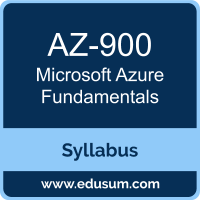 Use this quick start guide to collect all the information about Microsoft Azure Fundamentals (AZ-900) Certification exam. This study guide provides a list of objectives and resources that will help you prepare for items on the AZ-900 Microsoft Azure Fundamentals exam. The Sample Questions will help you identify the type and difficulty level of the questions and the Practice Exams will make you familiar with the format and environment of an exam. You should refer this guide carefully before attempting your actual Microsoft MCF Azure certification exam.
Use this quick start guide to collect all the information about Microsoft Azure Fundamentals (AZ-900) Certification exam. This study guide provides a list of objectives and resources that will help you prepare for items on the AZ-900 Microsoft Azure Fundamentals exam. The Sample Questions will help you identify the type and difficulty level of the questions and the Practice Exams will make you familiar with the format and environment of an exam. You should refer this guide carefully before attempting your actual Microsoft MCF Azure certification exam.
The Microsoft Azure Fundamentals certification is mainly targeted to those candidates who want to build their career in Microsoft Azure domain. The Microsoft Certified - Azure Fundamentals exam verifies that the candidate possesses the fundamental knowledge and proven skills in the area of Microsoft MCF Azure.
Microsoft Azure Fundamentals Exam Summary:
| Exam Name | Microsoft Certified - Azure Fundamentals |
| Exam Code | AZ-900 |
| Exam Price | $99 (USD) |
| Duration | 65 mins |
| Number of Questions | 40-60 |
| Passing Score | 700 / 1000 |
| Books / Training | AZ-900T00-A: Microsoft Azure Fundamental |
| Schedule Exam | Pearson VUE |
| Sample Questions | Microsoft Azure Fundamentals Sample Questions |
| Practice Exam | Microsoft AZ-900 Certification Practice Exam |
Microsoft AZ-900 Exam Syllabus Topics:
| Topic | Details |
|---|---|
Describe Cloud Concepts (25-30%) |
|
| Describe cloud computing |
- Define cloud computing - Describe the shared responsibility model - Define cloud models, including public, private, and hybrid - Identify appropriate use cases for each cloud model - Describe the consumption-based model - Compare cloud pricing models - Describe serverless |
| Describe the benefits of using cloud services |
- Describe the benefits of high availability and scalability in the cloud - Describe the benefits of reliability and predictability in the cloud - Describe the benefits of security and governance in the cloud - Describe the benefits of manageability in the cloud |
| Describe cloud service types |
- Describe infrastructure as a service (IaaS) - Describe platform as a service (PaaS) - Describe software as a service (SaaS) - Identify appropriate use cases for each cloud service type (IaaS, PaaS, and SaaS) |
Describe Azure architecture and Services (35-40%) |
|
| Describe the core architectural components of Azure |
- Describe Azure regions, region pairs, and sovereign regions - Describe availability zones - Describe Azure datacenters - Describe Azure resources and resource groups - Describe subscriptions - Describe management groups - Describe the hierarchy of resource groups, subscriptions, and management groups |
| Describe Azure compute and networking services |
- Compare compute types, including containers, virtual machines, and functions - Describe virtual machine options, including Azure virtual machines, Azure Virtual Machine Scale Sets, availability sets, and Azure Virtual Desktop - Describe the resources required for virtual machines - Describe application hosting options, including web apps, containers, and virtual machines - Describe virtual networking, including the purpose of Azure virtual networks, Azure virtual subnets, peering, Azure DNS, Azure VPN Gateway, and ExpressRoute - Define public and private endpoints |
| Describe Azure storage services |
- Compare Azure storage services - Describe storage tiers - Describe redundancy options - Describe storage account options and storage types - Identify options for moving files, including AzCopy, Azure Storage Explorer, and Azure File Sync - Describe migration options, including Azure Migrate and Azure Data Box |
| Describe Azure identity, access, and security |
- Describe directory services in Azure, including Microsoft Entra ID and Microsoft Entra Domain Services - Describe authentication methods in Azure, including single sign-on (SSO), multi-factor authentication (MFA), and passwordless - Describe external identities in Azure, including business-to-business (B2B) and business-to-customer (B2C) - Describe Microsoft Entra Conditional Access - Describe Azure role-based access control (RBAC) - Describe the concept of Zero Trust - Describe the purpose of the defense-in-depth model - Describe the purpose of Microsoft Defender for Cloud |
Describe Azure management and governance (30-35%) |
|
| Describe cost management in Azure |
- Describe factors that can affect costs in Azure - Compare the Pricing calculator and the Total Cost of Ownership (TCO) calculator - Describe Cost Management capabilities in Azure - Describe the purpose of tags |
| Describe features and tools in Azure for governance and compliance |
- Describe the purpose of Microsoft Purview in Azure - Describe the purpose of Azure Policy - Describe the purpose of resource locks |
| Describe features and tools for managing and deploying Azure resources |
- Describe the Azure portal - Describe Azure Cloud Shell, including Azure Command-Line Interface (CLI) and Azure PowerShell - Describe the purpose of Azure Arc - Describe infrastructure as code (Iac) - Describe Azure Resource Manager (ARM) and ARM templates |
| Describe monitoring tools in Azure |
- Describe the purpose of Azure Advisor - Describe Azure Service Health - Describe Azure Monitor, including Log Analytics, Azure Monitor alerts, and Application Insights |
To ensure success in Microsoft MCF Azure certification exam, we recommend authorized training course, practice test and hands-on experience to prepare for Microsoft Azure Fundamentals (AZ-900) exam.
